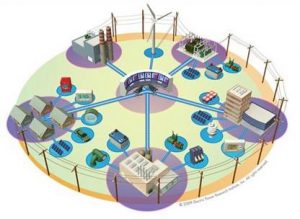 Microgrids enable businesses to function normally during outages caused by extreme weather. The share of global energy produced by microgrids — mini independent power grids created from several power sources working in parallel or independently from the main electricity grid — is growing rapidly.
Microgrids enable businesses to function normally during outages caused by extreme weather. The share of global energy produced by microgrids — mini independent power grids created from several power sources working in parallel or independently from the main electricity grid — is growing rapidly.
By 2026, according to the consultancy’s projections, the ratio of new power supplied by microgrids to new centralised capacity will be more than three to one. At that point, the global market for hardware, system controls and integration with existing grid infrastructure will be worth $26bn.
Ensuring that there is a resilient power grid in the face of extreme weather events has been a driving force behind microgrids in the US. While California has seen the largest number of power outages for each of the past nine years, other US states are catching up, according to the Eaton Blackout Tracker which explores the causes and effects of power cuts.
“Recent growth in microgrids in the US is tied to extreme weather events and the corresponding power outages, especially along the East Coast, but most recently in Texas, Florida and Puerto Rico,” says Peter Asmus, director of microgrids at Navigant Research.
Microgrids are having the biggest impact in the developing world, however. Asia Pacific boasts the largest share of global microgrid power capacity — with 41 per cent of the local market. The region is followed by North America (31 per cent), the Middle East and Africa (14 per cent) and Europe (8 per cent).
Besides integrating several power sources — including solar, wind, natural gas, diesel and battery — the essential innovation of the new grid is the algorithm that gets them all to work together. This will provide a steady power supply by way of an alternative energy local grid capable of sustaining itself indefinitely and independently of a large centralised grid.
Universal access to energy by 2030 will require that 35 per cent of new power connections be provided by microgrids, according to the International Energy Agency.
An important lesson of last year’s forest fires around Stone Edge Farm was the resilience of the grid’s local control system, says Mr Wooster. “It supported the grid’s autonomous functioning without outside control. This means power can be maintained even when parts of the grid fail.”
Source: “Smart Grids Show Their Power in Adversity”, Financial Times
